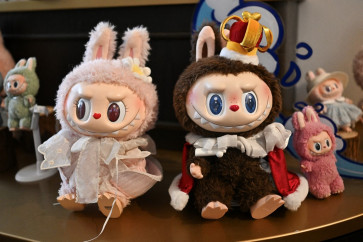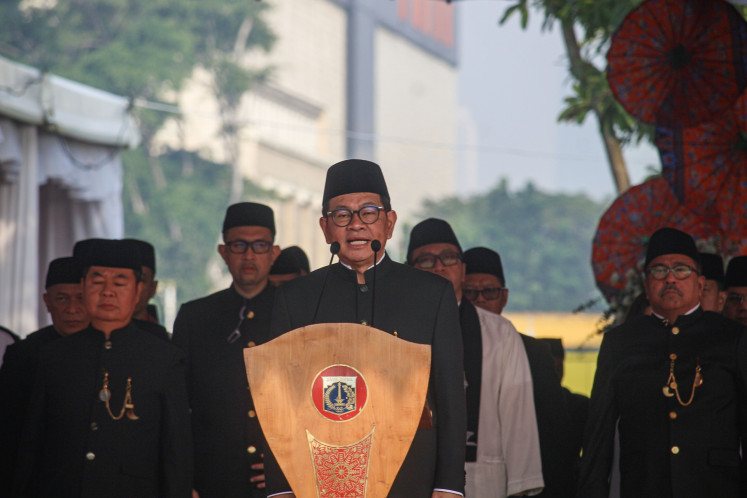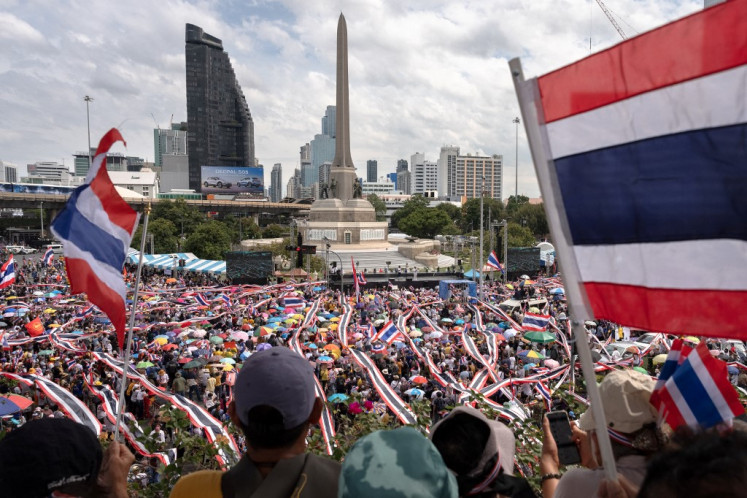Popular Reads
Top Results
Can't find what you're looking for?
View all search resultsPopular Reads
Top Results
Can't find what you're looking for?
View all search resultsIn love with rare Indonesian textiles
Ceremonial hanging, kampuh, from northern coastal area of Java, collected in Lampung, South Sumatra, possibly dated from 19th century
Change text size
Gift Premium Articles
to Anyone

C
span class="caption" style="width: 298px;">Ceremonial hanging, kampuh, from northern coastal area of Java, collected in Lampung, South Sumatra, possibly dated from 19th century. Five Centuries of Indonesian Textiles
Collectors seem to have a remarkable talent for finding treasures. Fashion lovers will travel from one fashion week to another to get the latest designs; art enthusiasts will go all out to get original pieces of work.
Mary Hunt Kahlenberg knew exactly what she was looking for when she scoured different islands in the country — from Java, Sumatra and Sulawesi — over 35 years.
The textile expert, fully aware of Indonesia’s rich textile heritage, was determined to further study the country through its fabrics.
Her persistence presented her with hundreds of wonderful original pieces, including cloth dating back as far as the 15th century, as shown in her latest book — Five Centuries of Indonesian Textiles, which features more than 350 textiles, mostly ceremonial costumes, and is illustrated with 300 detailed photographs.
During a recent presentation and book signing event in a heritage house in Menteng, Central Jakarta, Kahlenberg shared her stories on how Indonesian textiles had stolen her heart.
She said the door to Indonesian textiles opened when she was examining photographs from Dutch scholar and dealer Laurens Langewis, who offered to sell a small selection of Indonesian cloth.
At that time, she was a curator in charge of eastern hemisphere textiles at the Textile Museum in Washington DC.
“I was fascinated by one particular photo. It’s called cumi-cumi [squid] tapis,” she said.
She said she was so excited and tried to get the museum to buy it, but to no avail.The Sumatran garment, however, has secured a soft spot in her heart.
After becoming head of the Costume and Textile Department at the Los Angeles County Museum of Art (LACMA) in 1969, she explored Indonesia to purchase its textiles for the museum.
In 1977, Kahlenberg organized an exhibition of Indonesian textiles at LACMA, which was known as the first major presentation of Indonesian textiles in North America.
After the presentation, which was her farewell exhibition, she traveled to the archipelago at her own expense, collecting great examples of textiles at any time and place.
Kahlenberg’s journey in search of fine traditional garments in Indonesia resulted in satisfaction, with her meeting numerous dealers and villagers who showcased a number of marvelous rare and old garments.
“I went many times to many villages all over Indonesia. I would sit with the ladies and we would talk.
Then they would show me their textiles,” she said.
Sometimes they would want to sell the textiles, especially when they had children in school or needed a motorbike, she said.
She said people in the villages generally set the price high, so she would bargain.
“But if the price is reasonable, then I will not bargain,” she smiled.
She recounted a memorable experience with a male dealer whom she met during a ceremony when she visited Tana Toraja in South Sulawesi.
“He came to my hotel from a location which was quite far,” she said.
The man, who walked to her hotel, showed her a rag covered with mud.
“I knew it was a rare, early textile. I was very excited, so we talked about the price,” she said, adding that she did not have time to actually check the condition of the piece because she was in a hurry to catch a flight.
After arriving at a friend’s house in Jakarta, she washed away the mud to see the piece as she could not take mud into the US.
“I washed it by myself and the household chef was not very happy … they thought my clothes were very dirty,” she said, giggling.
Her effort paid off. After washing away the mud, she discovered a treasure — a beautiful, finely woven mbesa tali tau batu, a ceremonial head cloth from the 16th or 17th century.
Kahlenberg admitted that while collecting hundreds of ceremonial garments in Indonesia, she had one favorite piece — a ceremonial hanging called kampuh, a man’s ceremonial skirt cloth from the north coast of Java.
The piece stole her heart when she was choosing some garments in a dealer’s house in Lampung. “I looked at many textiles, but I really loved that one,” she recalled.
At that time, she knew she was going to buy several pieces from the dealer but to get a better price, she put her favorite piece of fabric in a corner, in the hope that the dealer would think she did not want it.
But her bargaining trick failed since the dealer knew the fabric’s fine quality.
Kahlenberg finally bought the kampuh even though it was not in the best condition.
“I just knew that I was going to love that fabric no matter its condition,” she said.
Her other private Indonesian garment pieces include a heirloom ceremonial cloth from 19th century bidak from Sumatra, tapis from Lampung province, tampan from South Sumatra and a woman’s head cloth and a man’s hip cloth from West Sumatra.
Loving a garment first before learning more about it might have been the very thing that took Kahlenberg on her long textile journey and gave her extensive knowledge about textiles.
She remembered discovering a hatbox filled with snippets of silk ribbons, some striped in amazing colors, others with flowers in lush velvet, as well as lengths of heavy silk grosgrain in her family’s New England attic.
Almost all of it was leftovers from the changing adornments of her female ancestors’ hats. Her grandmother, Grace Barnes, later put them together in the form of a quilt she made for her as a wedding present.
She said the box of ribbons passed down by women in her family was similar to the passing of information from one generation to the next in Indonesia.
She said she was moved by the tantalizing colors and sensuous textures and by memories her family shared with her as a result of this fascination.
“I give these ribbons credit for making me pursue the pleasures of textiles,” said the Kahlenberg, whose education and work are dominated by textiles.
After earning a BA in art history from Boston University, Kahlenberg pursued her graduate studies in Europe and at the Art Institute of Chicago.
She worked at the Textile Conservation Center in London and The Textile Museum in Washington, DC before becoming senior curator at the Los Angeles County Museum of Art.
She currently resides in Santa Fe, New Mexico, where she has curated two major collections of textiles and folk art.
As a textile expert, she has written numerous journals and catalogues as well as a number of books, including Textile Traditions in Indonesia, Walk in Beauty: The Navajo and Their Blankets.
She has also served as editor on several major textile and costume related publications.
Kahlenberg, who happily spent her holiday in Ubud, Bali, said she put the hundreds of textiles in her collection in a temperature-controlled room or art storage in a secure place.
When asked whether she would publicly display the collection in a future exhibition in her gallery or a museum, she simply smiled and said, “Not at the moment.”
Her passion for Indonesian garments is fully supported by her husband, Rob Coffland, who accompanied her on her travels to many places across the country.
Both are the owners of TAI Gallery-Textile Arts in Santa Fe, New Mexico, which features traditional textiles, Japanese bamboo arts and contemporary Japanese photography.
“My husband began to love textiles after I introduced them to him,” she said.
Kahlenberg said she also had lots of beautiful batik at home, which also fascinated her husband. “My husband said I had the most beautiful dowry, and he was marrying me for my dowry,” she smiled.
Inside tips
Selecting treasures like traditional fabrics from early periods requires careful and thorough examination.
Kahlenberg advised beginners wanting to start collecting textiles to buy something that they consider beautiful and learn about it.
“You’ll continue to buy better things, but you must always look at all the details, whether it is a good one or ordinary. You must know the difference,” she said.
Kahlenberg said she paid close attention to details such as color, technique used to make the cloth, pattern and texture before picking any cloth.
“I would run my fingers down stacks of them, sensing the quality and mellow natural dyes and fine textures,” she said.
Some knowledge about textiles being purchased, she said, was advantageous to avoid tricky people who would otherwise try to sell ordinary cloth.
“You have to know how fine the work, how strong the color, how beautiful the textile to you. Is it raw woven? What do you know about the people? The more you know the better.”
Another way to avoid being cheated is to find someone you can really trust who has adequate knowledge to tell the difference and help you purchase the textiles.
She said a chance to touch rare and beautiful cloth should be well practiced and such an opportunity would become a dream once the fabrics enter a museum.









